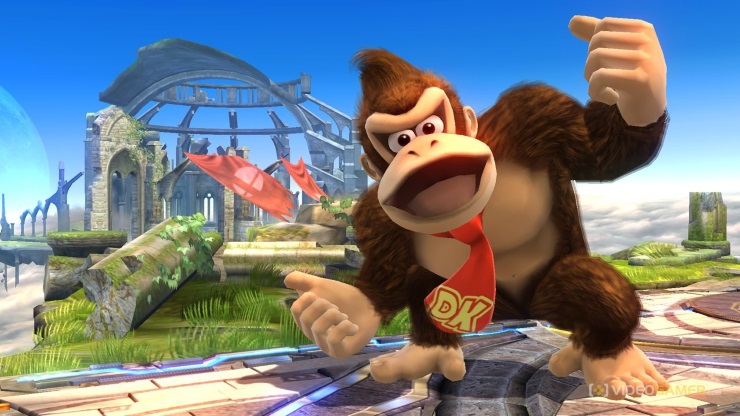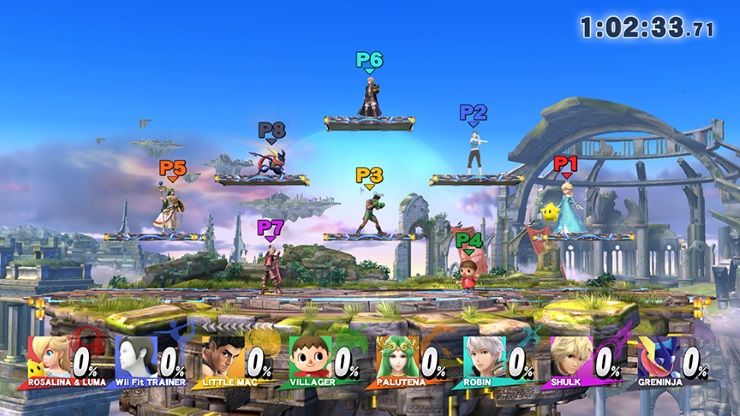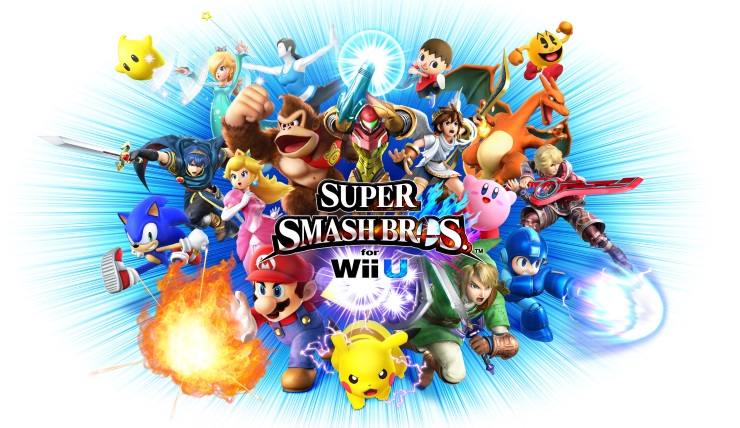November 28, 2014.
I can see it now. Many moons ago there was a table at Namco Bandai, and upon that table every different mode or feature of Super Smash Bros. Brawl was laid out. The purpose of that table was to answer the question: how do we make this better?
Then mode by mode, feature by feature, the group of designers tasked with making the first ever HD Super Smash Bros. went through and noted down at least one way to improve each element. From logical evolutions to drastic overhauls, every part of its DNA was changed or built upon in some way, and from that table, and many moons of work, Super Smash Bros. for Wii U was born.
That might not be exactly how it happened, but it’s the almost romantic image I have in my head after playing Super Smash Bros. for Wii U. It was the screenshot feature that put the impression there. Ever since the N64’s Super Smash Bros. you’ve been able to pause the game, zoom in and move the camera around the fighters and then in Brawl you could save those pause screens as screenshots. Now? Now you can doodle on those images.

It’s a silly aside, but it shows the designer’s desire to improve everything. You can imagine them just hashing it out, just having fun with the idea. It’s inconsequential and has no impact on the core action, but it shows a commitment to fleshing out the entertainment value of every aspect of what was already a series renowned for its generous spread of content and features.
Of course this is all side salad to the main course. As while you have silliness like that, Smash is still primarily a fighting game, albeit one with lots of platforms and a screen often bursting with players. The gist? You and a range of Nintendo all-stars enter an arena and proceed to beat each other up with standard and special attacks, alongside items and other stage hazards, with the ultimate aim being to send your opponents flying off the stage. The more damage you’ve sustained the further you fly from a hit, and so the more danger you’re in of being knocked out. As with any fighter, the character you select has a big impact, with each different face promoting a variety of different tactics. Link from The Legend of Zelda uses all manner of items to keep opponents at bay, for example, while Mario is a more upfront kind of brawler, preferring to grab foes and pummel them off the stage with big punches.
Even when talking basic fights and characters, I can think of two ways that this Wii U version adds to the series. In terms of characters, there’s a more diverse range of fighting styles than there’s ever been in the franchise before, as was explained in the review of this title’s sister product, Super Smash Bros. for 3DS. On top of this, and this is exclusive to the Wii U version, you can play with eight fighters locally at the same time. It’s chaotic, strangely beautiful, and certainly a worthy addition to the series alongside the more interesting roster.
I suppose now might be a good time to address the elephant in the room: that 3DS version. These two games are mechanically identical, and that’s worth remembering. To play a match as King Dedede on Smash 3DS will give you the same experience as on Wii U. You can even use a 3DS as a controller for Smash Wii U if you wish. The thing is, the Wii U edition embarrasses Super Smash Bros. for 3DS when you stack them side by side.
For starters, there are more modes, with the likes of event match making an improved return after their notable absence in 3DS. It also has expanded modes, with Target Smash having three levels rather than one. More music, more trophies, more Nintendo history, more inventive stages, more interesting bosses, a stage creator, a way to sample retro titles, 60 frames per second Pikmin – in Smash for Wii U you can make silly dioramas with the trophies you collect, and then you can draw on the screenshots you take (yes I mentioned it again, but it really never gets old).
Ultimately it’s the quality of the content as much as the spread that cements Super Smash Bros. for Wii U as such a solid package, with the challenge mode being a key point of comparison. Both games include this achievements-like system that aims to reward exploring the game’s content, but while Smash 3DS quickly becomes a case of ‘do everything with everyone’, the Wii U’s Challenge mode is more inventive. Survive for a minute in Cruel Smash as Luigi? Hit the sandbag between 500 and 505 meters in home run contest? These are fun, sometimes unexpected challenges that show a better understanding of why this mode exists.

Smash Tour is another example of better executed design. Exclusive to Wii U, Smash Tour is a board game take on Smash Bros. Essentially you move around a game board collecting trophies, power-ups and fighters, engaging in fights if you meet other players, and then after a set number of turns the winner is decided through a big brawl where the player’s use their stock of collected fighters in a single match. This is a fun party mode with friends that infuses Smash with a nice dollop of Mario Party’s unfair humour to keep things entertaining. It’s not perfect – though by virtue of its design it doesn’t aim to be mechanically infallible – but as a new way to play Smash it’s a revelation next to the undercooked and anticlimactic Smash Run that was introduced in Super Smash Bros. for 3DS.
Not that I’m trying to undervalue Super Smash Bros for 3DS – that’s still an excellent way to enjoy Smash on the move – it’s just that what’s here is so broad, varied and well designed in its entertainment potential that it merits celebrating how superior it is, particularly when Nintendo is so keen to push them as such a tight knit pairing. They are a pairing, sure, but where Smash 3DS is your dojo on the go, Super Smash Bros. for Wii U is the real deal.
The Wii U version isn’t perfect, though. A lot of it is great, what with event matches returning, fighters being varied, eight player smash being an absolute riot, the new survival mode Crazy Orders being excellent, the new stages being largely solid, and Amiibo being a good giggle (Amiibo are unessential to the core Smash Wii U experience however, and will be covered in a separate article), it’s just that a few things didn’t go through the initial improvement phase necessarily being changed for the better.
Classic mode isn’t so classic anymore. While fun, the new format of choosing fights from a big board of potential scraps lacks the simplicity of the previous, more traditional arcade mode, and many will miss, well, classic classic. The lack of an adventure mode may rub some the wrong way too, but considering the amount of quality, highly re-playable modes on offer, I can live without another Sub Space fiasco. What’s not so easily accepted, however, is the continued devolution of target test. What was an invaluable training tool in Melee and a fun diversion in Brawl is now completely missing, replaced, as in the 3DS version, with a silly Smash Bros. Angry Birds rip off.
The online features are almost identical to those of the 3DS version. While they come with the same shortcomings, it is still a nice range of options and finding a match is as quick and painless as on 3DS. There is one great addition, however, in the form of local online co-op. Going into team games with a friend through the same Wii U is a great option, and a welcome one given that there’s no other way to play the matchmaking team modes with friends. Connection quality is also very good, and an improvement on the 3DS. When working well you’d be hard pushed to realise that you’re playing online, it’s that smooth. It’s not perfect,b though, and I did encounter one lag-y match, but it is a superior online experience to the 3DS version.
My only other significant gripe would be the game’s lacklustre attempt to appease “serious” Smash fans (those that play with items turned off to create a more balanced playing field) through Omega stages. These are simply visual variants of the game’s flat Final Destination stage. Considering that it includes so many meaningful improvements and additions for Smash’s many other styles of player, it’s a shame that the Omega form is a weak improvement that fails to understand Smash fan’s love of varied platform layouts. It’s the randomness these players seek to eliminate with their rules, not the platforms. But then if you’re the sort to consider this a problem, then the precise level editor could be pointed to as a mild solution, considering that it does give you the ability to draw exactly the levels you want via the Gamepad (what Smash 4’s level editor loses in gadgets from Brawl it makes up for in precise geometry creation). To be fair, though, the more interesting character roster and potential of custom moves are huge improvements for this style of player, and are things that are bound to help Super Smash Bros. for Wii U appeal to more hardened fight fans.
But even though the Omega stages aren’t a huge success, they have still tried. They still looked at this player base and thought ‘this could make the game more fun for them’, which was more than they did with Brawl – which was a game that seemed to be developed using the far more simple ‘make it bigger’ approach. So for its misses (which are, in the grand scheme of Smash Bros., quite minor) this is still a more expanded, more generous, and more varied Smash title than any that have come before it. Nintendo enthusiast, party game fan or serious scrapper, no matter why you enjoy it, this is better than it’s ever been before.
Character roster is more varied than ever.
New modes of play are fun additions.
Number of worthwhile collectibles is beyond generous
Some alterations to classic modes aren’t 100% successful.
Omega stages feel undercooked for their audience.
Every element of the Smash Bros. package has been built on and expanded in new, sometimes unexpected ways, to create the most comprehensive and entertaining Smash Bros. title to date.



